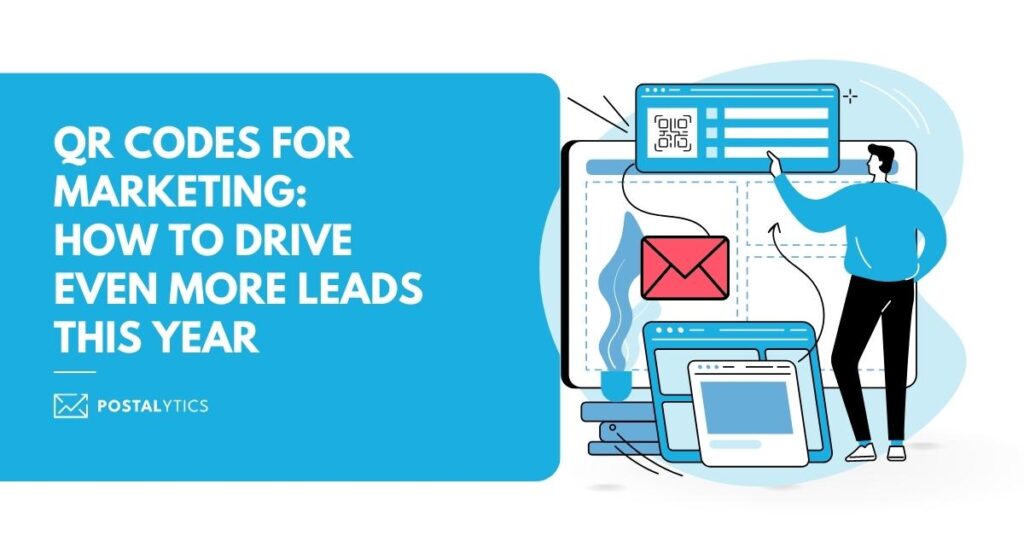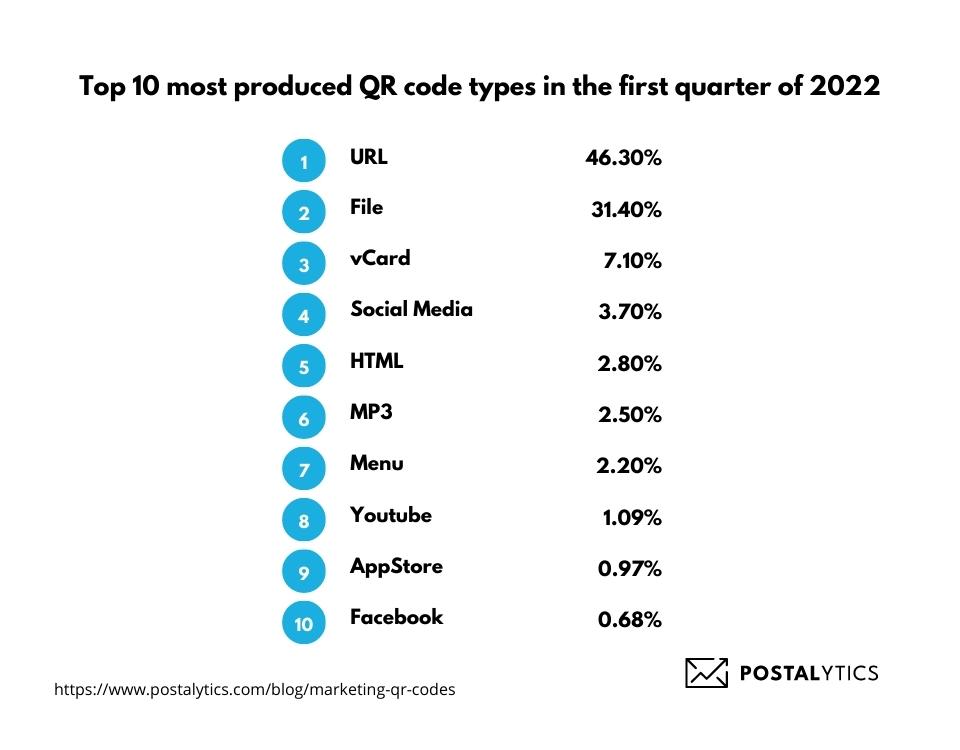
QR codes have come a long way since they were developed for tracking individual components in car factories in the early 1990s.
They were once called a dying fad. However, with the Apple iOS 11 update that allowed users to scan QR codes in their native camera app and the pandemic forcing people to look for contactless options, QR codes delivered a global technological earthquake.
Statistics prove the same. Dynamic QR codes generated 6.8 billion scans from global users in 2022, a 433% increase when compared to the year prior.
QR codes are now finding home in restaurant menus, postcards, letters, websites, events, and so forth.
As a leading direct mail automation platform, we spend a lot of time understanding how businesses use QR codes in direct mailing campaigns and other marketing initiatives.
Here’s a guide that will help you with creative QR code ideas to get ahead this year.
What We’ll Cover:
- What is a QR Code?
- What is QR Code Marketing?
- Why use QR codes in your business?
- How to use QR codes in your marketing strategy?
- #1 QR codes and pURLs in Direct Mail Marketing
- #2 Incorporate QR codes into your business card
- #3 Offer incentives and coupons via QR codes
- #4 Use QR codes to ask for reviews
- #5 Use QR codes to improve the customer experience
- #6 Calls-to-action on physical items
- #7 Integration with search and social ads
- #8 Providing consumers with more information on products
- #9 Use QR Codes for payment platforms
- The Key Points for Deploying QR Codes in Marketing
- Final Thoughts
What is a QR Code?

QR code stands for Quick Response Code which can be scanned and decoded by different devices such as scanners, mobile phones, and tablets. It uses pixels arranged in a square grid to store information such as links to websites, songs, social profiles, and more.
These QR codes can be created via QR code generators and direct users to a specific course of action, such as making payments, reading menu cards, taking action on a landing page, etc.
What is QR Code Marketing?
QR Code Marketing is a type of advertising/promotional technique that uses QR codes for advertising products and services or increase brand awareness.
QR codes for marketing can be used in many ways, such as on flyers, business cards, billboards, and social media profiles. These strategies help companies to get app downloads, increase their following on social media, drive more traffic to the website, increase leads, share contact details, personalize the experience, build email lists, and so on.
For example, L’Oréal USA used QR codes inside taxis to engage customers stuck in traffic. This campaign promoted a range of different product lines that linked QR codes to videos about how to use these products and redirected them to the store page. At the end of this campaign, the brand managed to increase its app downloads by 80%.
Why use QR codes in your business?
The three major reasons businesses should adopt QR codes are
#1 They are cost-effective
QR codes can save a lot of printing costs and updation costs. For example, by placing QR codes in cafes and restaurants and providing QR code menus, updating items or prices can be easier.
In the same way, buying ad space in a newspaper or magazine can cost you thousands of bucks. With QR codes, you can easily take users to your landing page and save space that would have otherwise gone into printing lengthy information details.
#2 Tracks performance
There’s no easy way to measure how many people viewed your billboards. But let’s say you added a QR code to this billboard with the CTA “Scan to get a discount on your purchase.” With this, you can track how many people took action after seeing that billboard.
Some QR code generator platforms also are compatible with Google Analytics, which stores demographic and user behavior data. This data can be beneficial for creating future campaigns.
You can also embed QR codes in direct mail to track campaign performance with Postalytics. Recipients scan the QR codes to access landing pages or personalized URLs to complete a form or make a purchase. Postalytics tracks clicks and interactions in real-time and displays them in the Campaign Dashboard, showing response and conversion rates.
#3 Can store a vast amount of data
A traditional barcode can store around 20 digits, but a dynamic QR code can store approximately 7000 characters. They can also store data apart from numeric characters like binary codes, control codes, alphabetic characters, etc.
By linking it to videos, webpages, and material on the internet, you can link a vast amount of data to QR codes.
#4 Higher ROI with QR codes
QR codes can be used to enhance the customer experience by providing quick and easy access to additional information, sales page, or exclusive content.
Overall, QR codes are an effective tool for marketers to improve the ROI of their campaigns. When used well, QR codes increase engagement, improve tracking, and provide a cost-effective way to drive traffic to a website or landing page.
Marketers often embed QR codes in their direct mail campaigns, driving the recipient to the next step in the funnel, usually a website.
How to use QR codes in your marketing strategy?
Businesses today are coming up with unique campaigns that involve QR codes. Here are a few ways you can adopt, along with some real-life examples to get you inspired.
#1 QR codes and pURLs in Direct Mail Marketing
You can drive your mail recipients online by implementing QR codes in your direct mail initiatives. With Postalytics, this becomes even easier.
You can drive recipients to your personalized URLs with a few simple steps. You can even drag, drop, and size these codes with the Postalytics template editor.
The best part? Tracking is possible within the platform so that you know the conversions of your pURLs.
#2 Incorporate QR codes into your business card
Implementing QR codes in your business card is one of the easiest ways to get started with QR code marketing.
This also makes your business card look unique, and with a scan, the recipient can open your website, contact you, see your location on Google Maps, or follow you on social media. You can even edit this information as often as you want without reprinting your cards.
You can even leverage card analytics and metrics to get access to first-party data, which includes data like the number of unique visitors and card scans, card scans by location and time of day, devices used to scan, etc.
Here’s an example of how to use QR codes in your business cards.
#3 Offer incentives and coupons via QR codes
If there’s one thing we all love, it’s getting our hands on discount offers and great deals. In fact, American consumers spend 13 million hours per week searching for online coupons.
By adding coupons and other incentives to your QR codes, you can increase the traffic to your website and stores. With QR codes, you can even track the offer’s effectiveness and modify them to generate more leads.
With coupon QR codes, you can get insights into your customers, the type of segments that use these codes more, the effectiveness of your offers and even products and marketing materials, etc.
Postalytics offers an easy and quick way to implement a professional direct marketing coupon strategy for businesses of all sizes. You can create coupons within minutes, track coupon redemption rates with QR codes, seamlessly integrate with CRM and automate direct mail sending schedules.
Simply sign up for a free account, target your prospects, and send out your coupon campaign to boost sales within days. Get clicks through coupons with QR codes, and reap the benefits of sales promotion.
With that said, let’s look into how brands use QR codes for coupons and incentives.
#4 Use QR codes to ask for reviews
Surveys show that 9 in 10 customers read reviews before purchasing a product, and 58% say they would pay more for products with good reviews.
When so many brands compete for customers’ attention, customers find it difficult to trust any brand. A way out is by reading reviews and then purchasing a product.
In such a scenario, you can keep QR codes for reviews at places such as checkout stores, receptions, or even on invoices or receipts, where you can gently nudge the customer to quickly scan the code and leave a review for your business.
These QR codes can easily link to review platforms like Yelp, Google, and other sites or social profiles.
Here’s an example of how you could inculcate QR codes for review on invoices and receipts.
#5 Use QR codes to improve the customer experience
Almost 89% of businesses compete primarily based on customer experience. With products getting too similar, improving your customer experience can become a key differentiating factor that attracts and retains customers.
You can improve the customer experience at many touchpoints by implementing QR codes. For example, a customer could quickly scan the QR code on the product to place an order once they have used the product.
You could even introduce personalization into the picture. For example, JC Penney released “Santa Tags” on Christmas. The giver could record a personalized message which would play when the recipient scanned the QR code.
#6 Calls-to-action on physical items
Would you open a door if you didn’t know where it would lead you? Unless someone is set on discovering Narnia, most of us wouldn’t. The same is true with QR codes printed on product packaging without any call to action (CTA).
Instead of using QR codes as an afterthought, take help from your designers to incorporate them into your marketing assets so that they are eye-catching and encourage users to take action.
By using CTAs like “Scan to get a 10% discount” or Scan to get your hands on delicious recipe ideas,” you can improve your conversions.
#7 Integration with search and social ads
Although you can’t identify individuals on the initial scan of QR codes, you can apply this information for further use. For example, you can note the specific devices and locations used while scanning your QR code.
This data can then be integrated into your online ads campaign, like Google and Instagram ads.
Let’s take an example to understand this. Suppose someone scanned the QR code on a packet of noodles. That noodle brand could target this same device later when the user logs in to Instagram or Google.
This re-targeting helps you drive future conversions and increase your revenue.
#8 Providing consumers with more information on products
You don’t want to overwhelm your customers with too much information. This especially goes for the information printed on your product packaging.
Too much, and you might ruin the design and look of your packaging.
A better way is by implementing QR codes on your product packaging that stores all the extra information your consumer might need. There are many creative ways to use QR codes for this. Let’s check out five common use cases.
– Providing detailed nutritional information about your products, in the case of food or beauty products.
– Turn your customers into your loyal fans on social media by setting up QR codes that take them to your social profiles.
– Give product tips or helpful guides through QR code-linked videos.
– Share recipes or link your QR codes to PDFs and brochures so users can access information conveniently.
– Share your entire product range that you sell online to upsell or cross-sell your products.
#9 Use QR Codes for payment platforms
Digital wallet and UPI apps like Google Pay and Apple Pay come with an in-built scan-to-pay feature that allows users to make cashless and contactless transactions.
A recent study found that global spending through QR code payments will touch $3 trillion by 2025, up by $2.4 trillion in 2022.
This growth will be fueled due to a focus on financial inclusion in developing countries and developing alternative payment methods in developed nations.
It is also a very convenient and fast mode of payment for customers that add to QR code’s popularity for payment platforms.
Besides grocery stores and restaurants, many businesses also share this code with their customers for online payments.
The Key Points for Deploying QR Codes in Marketing
QR codes can be a great addition to your digital marketing strategy. But for them to succeed, here are five points you need to consider:
- Ensure your QR code is placed so your target user can easily see it and take the desired action. Setting it against a bright background can increase readability.
- The context and content of your QR code should be clear. For example, the user should know what they’d get when they scan the QR code. For example, if you’re promising them a guide, ensure the QR code is linked with the same. It shouldn’t bring the user to your website where they further need to search for that guide.
- Keep in mind the QR code proportion. For example, scanning will become easier if you distort the ratio slightly.
- Don’t confuse your audience by having multiple QR codes on one product. Ideally, one should be more than enough.
- Track the number of scans, demographics, and other useful data for your QR codes. You are missing out on key information if you don’t track this data.
Final Thoughts
We saw a lot of ideas and technology get revived and break barriers during the pandemic. One of them was QR code marketing. Today, QR codes have emerged in almost every sphere of the marketing industry. With more creative ideas from marketers and advertisers, we may see some revolutionary QR code campaigns in the future.
To get started with QR codes, you can inculcate them with your direct mail campaigns to bring that traffic online or to generate awareness about your brand. With Postalytics, you can combine the power of direct mail with QR codes on one single platform and improve conversions and revenue.
About the Author

Dennis Kelly
Dennis Kelly is CEO and co-founder of Postalytics. Dennis joined Boingnet, the predecessor to Postalytics, in 2013. Boingnet was focused on providing print and direct mail marketing service providers the ability to add digital marketing channels to their direct mail campaigns. Postalytics is Dennis’ 6th startup. He has been involved in starting and growing early-stage technology ventures for over 30 years and has held senior management roles at a diverse set of large technology firms including Computer Associates, Palm Inc. and Achieve Healthcare Information Systems.
